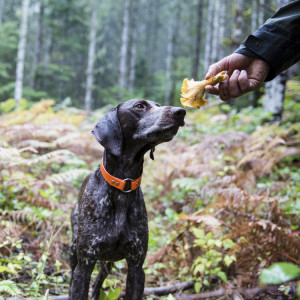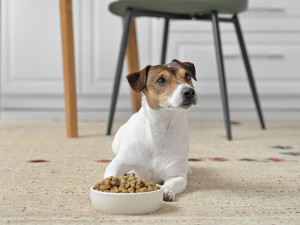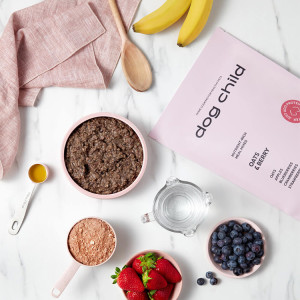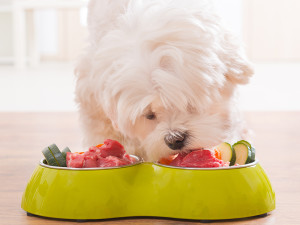8 in-Season Fruits and Veggies That’ll Make a Healthy Treat for Your Dog
Use this as your spring farmers' market shopping list for you and your pub.
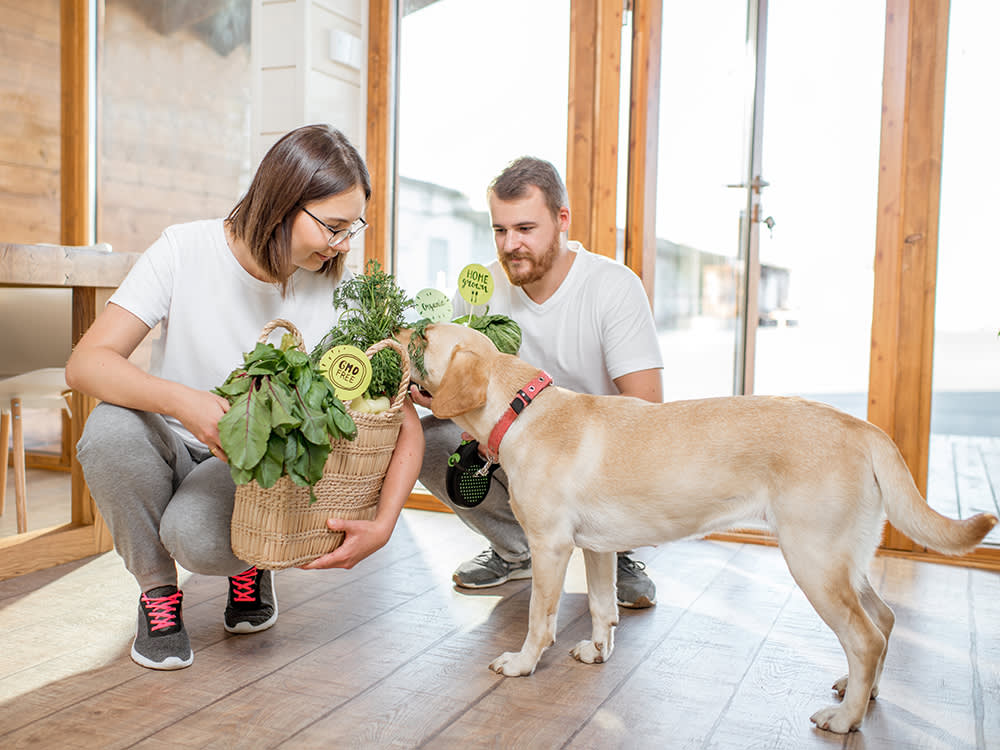
Share Article
People go to farmers’ markets for a number of reasons. Some want to support local businesses, others are delighted by the freshest produce available, and a select few just want a selfie with a raw eggplant. But tacky Instagram habits aside, there’s another motive you might not be aware of — dogs can also share in nature’s bounty.
Giving your pet a fruit or veggie snack, as a treat, is a great way to add extra vitamins and minerals to their diet. We asked Dr. Linda Simon, a consulting veterinarian at FiveBarks, which spring crops are good for your dog and why.
“While a complete dog food should contain all of the nutrients your dog needs, you can offer small portions of fruit and vegetables to their diet,” says Dr. Simon. “Though not necessary, dogs enjoy the taste, texture, and variety on offer from nature. As many fruits and veggies have health benefits, they’re a much better option than processed dog biscuits and treats.”
Not only are in-season fruits and vegetables tastier, but they’re also one element of eating more sustainably. We’re used to being able to buy strawberries in winter or oranges in summer, but those off-peak options most likely traveled long distances to get to us. Fruit from this season’s harvest is usually grown closer to home. If you have access to a farmer’s market, purchasing produce also goes hand-in-hand with eating locally.

As a general rule, you should talk to your vet before introducing anything new into your dog’s regular diet. Dogs come in all shapes and sizes and their dietary requirements are varied. Keep in mind that nutritionally-balanced food should still make up the bulk of your pup’s meals, while fruits and vegetables can be given to them as a topper or treat. Dr. Simon even has a tip for hotter days: “Why not blend some healthy fruit and vegetables into water and freeze them? Your dog will love this!” Below, we’ve listed the best dog-approved spring produce.
Carrots
Carrots are a year-round supermarket staple, but they’re only in season from late spring through fall. They also come in shades of orange, purple, red, white and yellow. We know that Bugs Bunny’s favorite vegetable is good for humans, but carrots also make a delicious, low-calorie snack for pups.
“Carrot is my all-time favorite veggie treat for dogs. Not only is it packed with Vitamin A (important for skin and coat health), it is also nature’s toothbrush,” says Dr. Simon. “The hard surface of a raw carrot is perfect for removing calculus and preventing tartar building up on your dog’s teeth. Replace your dog’s dental stick with a raw carrot and you’ll also be cutting down on their calories.”
Your four-legged friend can munch on either raw or cooked carrots, but because these root vegetables contain cellulose, which is almost entirely indigestible by dogs, it’s best to steam or puree them. If you do feed your dog raw carrots, cut the vegetable into sticks that are appropriate for their size to reduce the risk of choking, and supervise them while they eat.
Green beans
Crisp and snappy, green beans come into season from around May to October. We love them roasted and seasoned with a little bit of olive oil, lemon pepper, garlic, and red pepper flakes — but when it comes to your dog, plain is best. Your dog can snack on them raw, steamed, blanched, or canned, but if you buy a prepared option, check the ingredients list to ensure that it’s free from salt and other seasonings. Cut green beans to an appropriate size for your pup before giving it to them.
Green beans are low in calories and packed with vitamins and minerals, such as dietary fiber, protein, and Vitamins A, C, and K, as well as calcium, potassium, and phosphorus. While it’s not a common allergy, some dogs are allergic to green beans and may develop dry, itchy skin or even hives from eating them.
Garden peas
Nothing screams “spring” quite like pasta tossed with sautéed asparagus, cherry tomatoes, and fresh peas — be they garden peas, snap peas, or snow peas, which are all in peak season from spring through early summer. “Peas pack a powerful punch. High in protein and fiber and with a tempting, sweet taste, they can be added to your dog’s main meal,” says Dr. Simon. “Low in calories, they provide a range of vitamins and minerals including Vitamin A, B, and K as well as zinc and magnesium.”
Your hound will love fresh or steamed peas sprinkled over their kibble as a topper or as a treat. If you give them snap or snow peas, be sure to shell them first.
Cucumber
A warm-weather crop, cucumbers come into season from May through August. For you and you human friends, try the mini variety in smashed cucumber salads, tossed with soy sauce, sesame oil, sesame seeds, and red pepper. Your dog will appreciate their crunchy, juicy texture plain — sliced or cubed into bite-sized pieces, especially on a hot day.
Cucumbers make for a great low-calorie snack and alternative to commercial biscuits if your pooch is on a weight-loss plan, but be sure to feed it to them in moderation. According to the American Kennel Club, these cylindrical fruits (though they are vegetables in the culinary sense) should make up only 10 percent of your dog’s diet. But, while cucumbers are good for dogs, save the dill and gherkins for your sandwiches and falafel platters; pickles contain added salt and spices that your dog doesn’t need — or worse, additives that could harm them.
Radishes
It’s not rocket science why we gravitate towards radishes in spring, the root vegetable’s peak season. When raw, they’re crunchy and peppery. Roasted, they’re mild and creamy, similar to potatoes. And we love blending the greens into a pesto, which is equal parts delicious on pasta and great for reducing food waste. Your dog can enjoy radishes sparingly, because too much can make your pup gassy or cause diarrhea.
Radishes are low in calories and contain fiber, potassium, and Vitamin C, which are good for your dog’s digestion, heart function, and energy levels. To prep one for your pup, clean and peel it and cut it into bite-sized pieces. You can even add a little bit of peanut butter on top of the radish to make it more appealing to your dog. But chances are, they’ll likely appreciate a different vegetable!
Potatoes
Samwise Gamgee was right to love potatoes. They’re affordable, filling, and nutritious with versatility that’s seemingly endless. Although you can find potatoes at the market all year round, spring is the season for the long white and baby potato varieties, which are rich in vitamin C, vitamin B6, iron, and magnesium.
Raw potatoes can be toxic to your dog because they contain solanine, a compound found in members of the nightshade family. The greener the skin, the more solanine a potato contains; check tubers thoroughly before purchasing. Recent FDA research opens in new tab suggests that kibble with potatoes, peas, and pulses as the main ingredient can cause canine dilated cardiomyopathy. Before giving your dog potatoes, scrub, then thoroughly boil or bake them. Don’t add any seasoning, including onion and garlic, which are toxic in high amounts.
Cherries
Sweet cherries, such as the Bing and Rainier varieties, are the first stone fruit to come into season in spring. Your dog can enjoy tart cherries, too, while they’re in season during summer, but never give your dog maraschino cherries, because they’re high in sugar. Save those for your sundae. De-stem and pit cherries before using them as a healthy and tasty treat for your dog. The pits are a choking hazard and they can cause intestinal blockages. In addition to that, they also contain cyanide, which can be lethal.
These plump, juicy fruits are part of the “drupe” family, which includes apricots, nectarines, and peaches. The flavor of cherries can vary from sweet to disappointingly bland. The most delicious cherries for you and your dog will be dark in color for its variety and have a fresh, green stem.
Apricots
Delicate and fragrant with downy skin that holds a tender flesh that’s mildly sweet with underlying floral notes, apricot season takes place from May to July. Apricots are native to Central Asia and China, but in the US, approximately 75 percent of apricots are grown in California. Washington state just about makes up the rest, while less than one percent are grown in Utah.
These stone fruits are a good sweet treat for tail-waggers, so long as you remove the stem, leaves, and pit first. Just like cherries and other drupes, the pits contain cyanide. To give your dog an apricot, wash it and then slice it into appropriately bite-sized pieces. As for nutrients, apricots contain potassium and beta-carotene, and they’re a good source of fiber. Due to this, you should feed them to your dog in moderation. Too much can cause digestive upset, and lead your dog to asking for more bathroom breaks than usual.

Kat L. Smith
Kat L. Smith is a writer and editor based in Queens, New York. They have written for LIVEKINDLY about a wide range of topics related to sustainability, lifestyle, house plant care, and food. They share their apartment with their adopted dog, Layla, and Vivi, a one-eared cat.
Related articles
![Lauren Singer sitting on street step hugging her tan dog named Rose]()
Don’t Be Trashy: Follow Lauren Singer’s Low-Waste Pet Care Tips
The founder of Package Free says there’s a low-waste alternative to every pet product sitting in your trash right now.
![A person giving a banana to a dog.]()
10 Fruits and Vegetables That Your Dog Can Feast On
Indulge your pup (safely) with these delicious and healthy snacks.
![A young woman giving her German Shepherd mixed breed dog scratches in her kitchen]()
3 Reasons to Cook Your Own Dog Food
Adding a DIY component to your dog’s meals is a great, nutritious option.
![A dog sitting on the floor with a bowl of kibble.]()
Everything You Need to Know About Your Dog’s Gut Microbiome
Microscopic organisms may reveal pathways to better health for your pet.
![A photo of measured ingredients on a kitchen counter including; blueberries, bananas, strawberries, oats, etc.]()
Dog Child Is the Ultimate Cheat Sheet to Home Cooking For Your Dog
Founder Nicole Marchand has made home cooking easier with upcycled ingredients.
![White terrier eating fresh dog food]()
The Scoop on Human-Grade Dog Food
For starters, yes, it’s good enough to eat.


